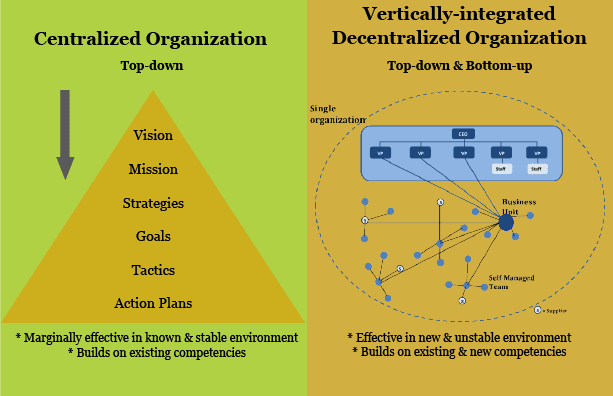This is a three-part blog, click here to read Part I and Part III.
In my July 2011 blog, Emerging Organization Designs – Part I: Models of Form I wrote about strategy shaping organizational design. Jay Galbraith (1995) furthers understanding of the organizational design process by stating “organizational design decisions are the shapers of the organization’s decision process”. In summing up these two statements, we can conclude that different organizational strategies require different organizational designs or structures.
A quick read of July’s blog will refresh your memory of three emerging organizational structures we are seeing in today’s market place, but what do we mean by organizational strategy and how does it fit in this framework? I am not surprised if it seems confusing to you as no real agreement exists in the business literature on a concise definition of organizational strategy.
Depending on which business author you favour reading, strategy is defined as:
– maneuvering into position (foresight and knowing what to do)
– fulfillment of policies and plans to create advantage
– a means (policies) to clear and visible ends (goals)
– directional decisions (purpose, mission) and actions (deployment of resources)
– a focused perspective (single driving force, clear core values)
– differentiating oneself in the customers’ eyes (competitive position, uniqueness)
– choosing a value discipline (customer intimacy, operational excellence, product leadership)
For the sake of brevity, understanding and the purposes of this blog, I coupled together the following definition:
Strategy is a perspective, position, and plan realized over time through a
pattern of decisions and actions (Henry Mintzberg) that differentiate
and deliver a unique mix of value (Michael Porter) to the customer.
Regardless, if one’s analysis of strategy crosses a broader view, in order for an enterprise’s business strategy to be successful, it must differentiate and deliver value from its customers’ perspective. What is implied here is clarity on and appreciation for what distinguishes the enterprise from all others. With this enterprise awareness of its uniqueness and of current customer demand to optimize operational excellence and innovation simultaneously, it follows that structures and systems are required to enable and coordinate decision-making.
In an hierarchical, centralized structure, such as in the figure below, each level in the organization has a different set of roles, responsibilities and decisions associated with it. Typically, strategy is the purview of the senior management team (CEOs and VPs) and seeks to answer “What?” — What business are we in? What assumptions do we hold? What global trends are impacting us? What are our goals – growth? excellence? profit? innovation?

As we move down the corporate ladder, tactics or ‘how tos’ become the focus point for deciding how the organization will achieve its strategic direction. In an economic environment of greater certainty (predictability) and stability (slower rates of change), the centralized hierarchy has proven itself to be effective in mastering scale and operational efficiencies. However, as the workforce became increasingly more educated and evolved into knowledge workers, their dissatisfaction with command and control structures (limited opportunity for meaningful work and involvement in decision-making) increased. In addition, as our business environment increased in complexity, unpredictability and speed, the traditional hierarchy’s ability to agilely coordinate decision-making decreased.
In an environment where the ‘unknowns’ and complexities are considerable and the speed of change and innovation is accelerated, strategic and tactical decisions must not only occur at a much faster pace but must include more people. Network organization structures — the vertically-integrated decentralized organization — have emerged in response to these new, unstable environments, which require business strategies to jointly optimize organizational efficiency and organizational innovation. While the hierarchy is best suited to optimize and standardize efficiencies, the network of self-managed teams best supports rapid innovation — two different structures for two different strategies.
In past decades, these two different structures would have existed in two separate organizations. Today, the efficiency hierarchy and the innovation networks exist in the same organization — two different structures for two different strategies within one enterprise. With two different leadership styles, two different decision-making processes, two different work systems and two different cultures all living under one ‘roof’, the potential for conflict and chaos is enormous. At the very least, within this kind of complexity, leading and managing call for a calm, collaborative disposition.
I am curious about your own enterprise or employer. Are you/they strategizing for efficiency as well as innovation? Does your structure(s) reflect these dual needs? Is your leadership able to support this duality?
To read Part I and Part III of this blog series, click the links.
Sources:
Galbraith, Jay R. 1995. Designing Organizations: An Executive Briefing on Strategy, Structure and Process, San Francisco: Jossey-Bass.
Mintzberg, Henry. 1994. The Rise and Fall of Strategic Planning, Basic Books.
Porter, Michael. 1996. “What is Strategy?” Harvard Business Review (Nov-Dec).
Porter, Michael. 1986. Competitive Strategy, Harvard Business School Press.
STS-RT Discovery Team. 2011. “Designing the Adaptive Enterprise.” Presentation at New Orleans Annual Meeting, September.




